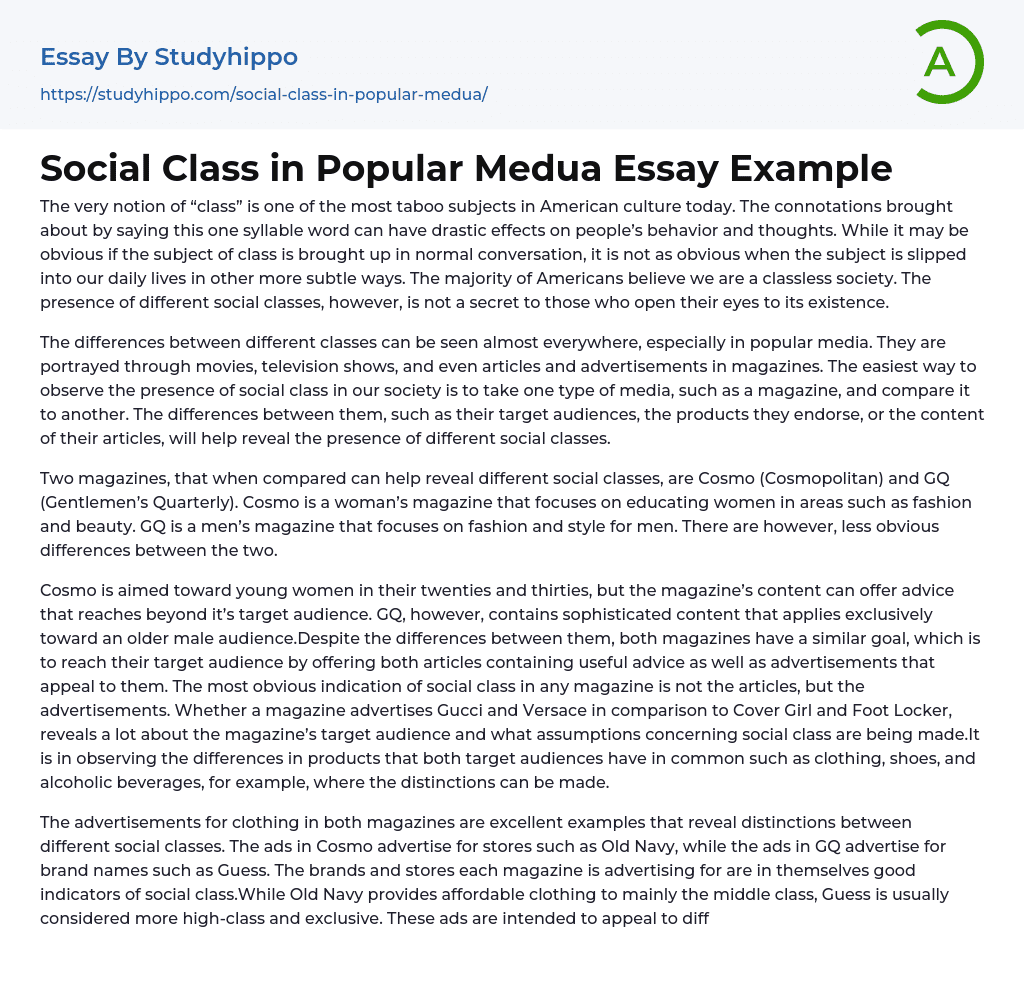The concept of "class" in American society is considered taboo and can greatly influence behavior and attitudes. It may surface in casual discussions or even subtly affect our daily habits. While some Americans strive for a classless society, others acknowledge the reality of social classes.
Evidence of social class in our society can be found in popular media, including movies, television shows, and magazines. Magazines targeting different social classes display variations in promoted products, subject matter, and intended audiences.
Two magazines, Cosmo (Cosmopolitan) and GQ (Gentlemen's Quarterly), have the potential to showcase various social classes. Although Cosmo concentrates on instructing women about fashion and beauty, GQ is dedicated to men's fashion and style. Nevertheless, there exist slight disparities between these two publications.
Although Cosmo targets young women in their twenties and thirties, its content provides advice t
...hat extends beyond their demographic. Whereas GQ features sophisticated content that caters exclusively to an older male audience. Despite these distinctions, both magazines aim to reach their targeted audience through articles and advertisements that are relevant to them. A magazine's advertisements, rather than its articles, divulge the most apparent indications of social class. Whether a magazine showcases Gucci and Versace, as opposed to Cover Girl and Foot Locker, speaks volumes about its intended readership and the social class assumptions being made. The divergence in products, such as clothing, shoes, and liquor brands shared by both target groups, is where the disparities can be observed.
The clothing advertisements featured in both magazines exemplify the differences between social classes. Cosmo's ads promote brands like Old Navy, catering to a predominantly middle-class market. In contrast, GQ's ads endorse high-end, exclusive brands such as Guess
appealing to a wealthier clientele. The brand choices of each magazine serve as strong indicators of social class, with the advertisements designed to resonate with their corresponding target audiences. Cosmo's audience, for example, mainly comprises working-class women in their twenties and thirties.
It can be inferred that Cosmo readers belong to a lower economic status as compared to GQ readers based on the advertisements present in both magazines. The majority of individuals in this class cannot afford high-end brands like Guess - which are the primary advertisements in GQ. The shoe and alcohol advertisements in Cosmo consist of Nike athletic shoes and Vodka, respectively. GQ showcases ads for Cole Haan footwear and Jameson whiskey.
The differences between the ads featured in Cosmo and GQ lie not in the brands being advertised, but in the ads themselves. Cosmo's ad campaign includes a woman jogging and a humorous take on gender stereotypes, both targeting their intended audience effectively - the former by creating a relatable scenario while the latter uses humor to build empathy. GQ, on the other hand, presents detailed product profiles for items like shoes and whiskey, using clear imagery and concise statements to appeal to their target market. Both magazines rely on stereotypical assumptions in order to cater to their respective demographics.
Both Cosmo and GQ make assumptions about their readers based on their advertising strategies. Cosmo assumes that relatable and humorous ads are more effective with readers because they are easier to comprehend, implying that lower class readers are not as intelligent as those in higher classes. On the other hand, GQ assumes that their readers are above using humor and everyday activities
to explain products to lower class individuals, indicating that higher class readers are not only more intelligent, but also more sophisticated.
The media wields significant influence over individuals through its representation of societal class distinctions. These distinctions, which permeate our daily choices such as clothing, drinks, and reading materials, are largely shaped by false assumptions and stereotypes attached to the concept of class in society.
Despite the constant presence of class distinctions, it is not difficult to recognize the actual social classes in America if we examine the media's biased portrayal of reality. By rejecting the media's perspective and thinking for ourselves, we can determine our own definition of social class.
- Sales Promotion essays
- Advertising campaign essays
- Advertisement essays
- Advertising essays
- Anheuser-busch essays
- Audience Theory essays
- Brand essays
- Brands essays
- Competitor Analysis essays
- Consumer essays
- Detergent essays
- Marketing Management essays
- Marketing Mix essays
- Marketing Plan essays
- Marketing Research essays
- Marketing Strategy essays
- New Product Development essays
- Point Of Sale essays
- Price essays
- Procurement essays
- Product essays
- Product Differentiation essays
- Product Placement essays
- Promotion essays
- Promotion And Marketing Communications essays
- Research Design essays
- Retailing essays
- Trademark essays
- Magazine essays
- Newspaper essays
- Anthropology essays
- Audience essays
- Charity essays
- Cultural Competence essays
- Emile Durkheim essays
- Gender Roles essays
- Generation essays
- Globalization essays
- Interpersonal Relationship essays
- People essays
- Race essays
- Social Change essays
- Social Class essays
- Social Movement essays
- Social Science essays
- Social Status essays
- Social Stratification essays
- Society essays
- Sociological Imagination essays
- Sociological Perspective essays




